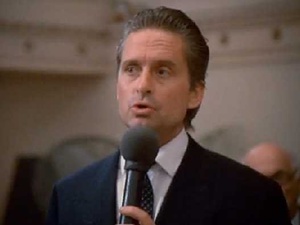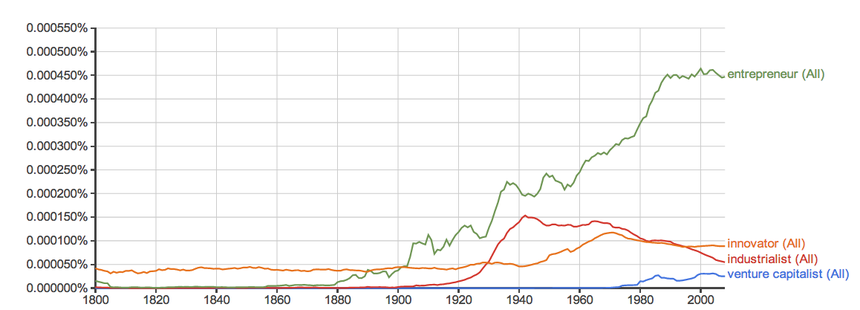The Origins of Office Speak
“Here’s your ‘buzzword bingo’ card for the meeting,” Wally says to Dilbert, handing him a piece of paper. “If the boss uses a buzzword on your card, you check it off. The objective is to fill a row.”
They go to the meeting, where their pointy-haired boss presides. “You’re all very attentive today,” he observes. “My proactive leadership must be working!”
“Bingo, sir,” says Wally.
This 1994 comic strip by Scott Adams is a perfect caricature of office speak: An oblivious, slightly evil-seeming manager spews conceptual, meaningless words while employees roll their eyes. Yet, even the most cynical cubicle farmers are fluent in buzzwords. An email might be full of calisthenics, with offers to “reach out,” “run it up the flagpole,” and “circle back.” There are nature metaphors like “boil the ocean” and “streamline,” and food-inspired phrases like “soup to nuts” and “low-hanging fruit.” For the fiercest of office workers, there’s always the violent imagery of “pain points,” “drilling down,” and “bleeding edge.”
Over time, different industries have developed their own tribal vocabularies. Some of today’s most popular buzzwords were created by academics who believed that work should satisfy one’s soul; others were coined by consultants who sold the idea that happy workers are effective workers. The Wall Street lingo of the 1980s all comes back to “the bottom line,” while the techie terms of today suggest that humans are creative computers, whose work is measured in “capacity” and “bandwidth.” Corporate jargon may seem meaningless to the extent that it's best described as “bullshit,” but it actually reveals a lot about how workers think about their lives.
The mechanistic worker came of age amid a whirl of turbines at the turn of the century. The Second Industrial Revolution was well underway, and the massive companies run by titans like Andrew Carnegie and Henry Ford relied on factory assembly lines.
In 1911, Frederick Winslow Taylor published The Principles of Scientific Management, a book with one goal: destroy worker inefficiency. His theory, often called “Taylorism,” was all about maximizing every action on an assembly line. “There was a shift to the logic of science and efficiency,” Rakesh Khurana, a professor at Harvard Business School and soon-to-be-dean of Harvard College, told me. “Divide work into its smallest component parts, figure out the timing, remove any unnecessary efficiencies. That was the way work was organized, and that had a huge impact on the way corporate culture was organized.” The words used to talk about workers in books and boardrooms were accordingly mechanistic, emphasizing accuracy, precision, incentives, and maximized production.

This idea started to shift in the late 1920s and ’30s. In 1924, the Australian sociologist George Elton Mayo started running a series of experiments at Hawthorne Works, a large factory of the Western Electric Company in the suburbs of Chicago. He set out with a simple task: figure out how the brightness of the lights in the factory affected worker productivity. But his team got some surprising results: Whenever the lights changed—no matter whether they got dimmer or brighter—workers got better at their jobs. They concluded that the workers’ physical environment wasn’t what made them better—it was that they thought their bosses were paying attention to them.
Mayo and his team quickly changed their focus: Instead of thinking of workers as cogs in a vast machine, they began thinking of them as living units of a large, complex social organism.
“In the 1930s, you begin getting this human relations perspective, in many ways in opposition to the scientific imagery,” Khurana said. “This is really about this notion that managers don’t understand the psychology of workers. By treating them as machines, they not only deny their humanity; it actually results in ineffective management, social disorganization, lack of cooperation, and an increase in tensions between labor and management.” Although the methodology of the Hawthorne experiment has since been criticized, the results triggered a shift in how researchers thought about workers.

This seemed to come at just the right time: The Great Depression had set in, and industries were in an existential crisis. “Alienation, abseentism, labor turn-over, wild-cat strikes—these came to be associated not with meeting the workers’ economic needs, but their psychological and social needs,” Khurana said.
World War II liberated these theories from the halls of academia. Suddenly, organizational science was seen as a possible tool for understanding what had happened to nations like Germany and Japan. “What was it about the culture of those societies that led them to suddenly shift from what was seen as quite enlightened and advanced to suddenly becoming very authoritarian? The government became interested in this, and they started funding all sorts of studies.”
At the same time, American companies were changing. “Most of the large organizations that were emerging at this time were not in any single business,” Khurana said. “They were large, diversified conglomerates that had been created as a consequence of World War II and of the huge mergers and acquisitions activity that took place in the 1950s and ’60s. Firms like Pepsico owned trucking companies, even though they were in the food business.”
This made it more difficult for workers to feel a connection to their companies, Khurana said. “What people were very much focused on was: How can we get workers to feel differently about their jobs?”
For academics, this was as much a question of sociology as efficiency. It soon became a question of money, too: “As a manager, how can I maximize profits by creating a certain emotional atmosphere at my company?”
In trying to answer this question, office speak was born.

The Self-Actualizers
In the 1950s, two schools of thought began to emerge. At Carnegie Mellon, academics were working on what they called management science—a theory of decision-making inspired by the computers that had come out during World War II. Meanwhile, at MIT, three professors—Douglas McGregor, Edgar Schein, and Richard Beckhard—were creating a new field called organizational development.
Schein, now 86, is largely credited with coining the term organizational culture (the linguistic cousin of corporate culture). “In the 1960s, there was an emphasis on humanistic psychology, involving the worker, because then they would work better,” he told me. “We were interested in how groups and leadership could be made more effective. So we started something called the human relations lab.”
A pair of hypotheses rose out of these labs. As McGregor explained in his 1960 book The Human Side of Enterprise, managers could think of their employees in one of two ways: as lazy work-haters who need to be closely supervised (Theory X), or as ambitious self-motivators who thrive in an atmosphere of trust (Theory Y). “This introduced the idea that effective managers believe in their people and trust them and don’t feel that they have to monitor them all the time,” Schein said.

Although the researchers didn’t necessarily favor one theory over the other, Theory Y fit perfectly with the zeitgeist of the 60s. It drew on Abraham Maslow’s increasingly popular theory of the hierarchy of needs, which positioned “self-actualization” as the highest goal of human life. Inspired by Maslow, Michael Murphy and Dick Price founded the Esalen Institute in 1962 to nurture the burgeoning Human Potential Movement, and Look magazine’s George Leonard helped bring it into the mainstream. Theory Y extended this worldview into the realm of work: Jobs, much like meditation and mind-enhancing drugs, were seen as a way to discover untapped inner power and find personal fulfillment. Over the years, the idea has stuck: In 2001, The Human Side of Enterprise was voted the fourth most influential management book in the 20th century by the Academy of Management.
In the decades that followed, academics continued to come up with memorable buzzwords. British psychologist Raymond Cattell repurposed the word synergy, which was originally a Protestant term for cooperation between the human will and divine grace. The UC Berkeley philosopher Thomas Kuhn popularized the term paradigm shift in his 1962 book, The Structure of Scientific Revolutions. And, much later, Harvard professor Clayton Christensen coined the term disrupt, which has become a favorite in today’s climate of start-up worship. But more importantly, academics have had a big effect on how workers work, all thanks to one group of people: consultants.

The Optimizers
Douglas McGregor may have written the fourth most influential management book of the 20th century, but Peter Drucker wrote the third: In his 1954 manifesto, The Practice of Management, he wrote that “the manager is the dynamic, life-giving element in every business.” Over the next five decades, Drucker helped companies find new ways to turn “resources”—people, in other words—into productivity engines.
In 1981, Drucker started working with one of his biggest clients: General Electric. The company had just been taken over by Jack Welch, who was looking to overhaul its management in the midst of a recession. Over the next decade, Welch systematically redesigned the culture of the organization, hitting a peak in 1989 with his Work-Out program, which was designed to help managers and employees solve problems faster. In the language of Work-Out, low-hanging fruit were problems that were easily identified and solved. Other fantastic jargon from the program included rattlers, or obvious problems (so-named because they “make a lot of noise”) and pythons, or challenging problems that come from bloated bureaucracy. A little ironically, Welch wrote that Work-Out would create “a company where jargon and double-talk are ridiculed and candor is demanded.”

Although Work-Out is credited with reinvigorating General Electric, other attempts to overhaul company culture failed miserably. After AT&T was broken up into multiple companies in 1984, the newly independent telephone service provider Pacific Bell hired two associates of Charles Krone, a California-based management consultant known for following the teachings of Armenian mystic Georges Gurdjieff. His “leadership development” program, known as “kroning,” maintained that certain words helped employees communicate better, improving the health of the organization. Some 23,000 employees went through the $40 million training program, learning new terms like task cycle and functioning capabilities that were supposed to help them care more about their work and express themselves more clearly.
Instead, the company’s language became incredibly opaque. For example, its 1987 “statement of principles” defined “interaction” as:
The continuous ability to engage with the connectedness and relatedness that exists and potentially exists, which is essential for the creations necessary to maintain and enhance viability of ourselves and the organization of which we are a part.
When the San Francisco Chronicle reported that the training had caused widespread discontent, the California Public Utilities Commission started an investigation, and the program was discontinued. “Perhaps one thing that we learn from the Krone case,” wrote University of Richmond professor Joanne Ciulla in 2004, “ is that attempts at engineering appropriate attitudes and emotions can actually undercut genuine feelings for a company.”
But even if firms like Bain, McKinsey, and Boston Consulting Group didn’t import New Age values into their consulting the way Krone and his associates did, they did develop distinctive, pseudo-scientific language to pitch themselves to clients. “They all had to come up with something new,” John Van Maanen, a management professor at MIT, told me.
For example, consultants are responsible for a lot of the veiled language used by today’s HR departments. “The consulting industry came up with a whole slew of euphemisms for firing people that has become universal,” said Matthew Stewart, the author of The Management Myth. “There’s a whole body of kind of Orwellian speak about developing human capital and managing people and all that.” Streamline, restructure, let go, create operational efficiencies: All of these are roundabout ways of saying that people are about to lose their jobs. The common theme among them is efficiency—after all, these are human resources, and what are resources for if not the company’s bottom line?
This is where consultants diverge from their management-scientist forefathers. They value worker satisfaction only to the extent that it can help a company run better. Consider the following buzzwords:
80-20, noun: Named by a consultant for economist Vilfredo Pareto, this is the principle that 80 percent of output comes from 20 percent of a company’s effort.
Boil the ocean, verb: This is a term for unrealistic expectations, supposedly coined by the humorist Will Rogers when he was asked what to do about German U-Boat aggression during World War I.
Sync up, verb: Derived from the mechanical term “synchronization,” this means “make sure everyone knows what’s going on.”
But consultant-speak wasn’t the only vocabulary trend of the 1970s and ’80s. Elsewhere in the business world, another kind of profit-driven jargon was on the rise: the language of Wall Street.

The Financiers
“In finance, the jargon tends to be aggressive—kind of frat-bot talk. It’s the same spirit: competitive and aggressive,” said Geoffrey Nunberg, a linguistics professor at UC Berkeley. Often, the words thrown around in emails and on trading floors are close cousins of those used in economic textbooks. In finance, even the buzzwords drip with money.
For publicly owned companies, this was a period of refocusing—on profit. Concerns about worker satisfaction and “human potential” largely faded from view; suddenly, business was all about rewarding the shareholder. The economist Milton Friedman summed up this theoretical shift in a 1970 New York Times column: “There is one and only one social responsibility of business—to use its resources and engage in activities designed to increase its profits.”

This idea shaped the way managers and employees thought and acted. And the language followed suit. “The expression optionality is something that came into vogue with the rise of derivatives,” said Stewart. “You can talk about standard deviations or other terms for establishing risk, like leverage. You hear that term everywhere, but it was originally a financial concept.” The term value-add comes directly from the idea of shareholder value: “Will this action directly increase profits for the people who own our company?”
As Wall Street grew more powerful, so did business schools. “In an executive training or MBA program … everybody talks about the multiplicity of networks: advice networks, mentoring networks,” Van Maanen said. He also pointed to the proliferation of new terms in the business press, like VUCA—a finance-world adaptation of a military acronym for Volatility, Uncertainty, Complexity, and Ambiguity. Terms like this, Van Maanen said, “create a bit of an in-group—a divide between those who can use it knowledgably [and those who can’t].”
This observation holds true across professions: A well-placed buzzword is a great way to claim membership in a certain tribe. But for marketers, there’s another useful application for office jargon: establishing a #personal #brand.

The Marketers
Marketing is having a glamour moment in pop-culture, largely thanks to the Emmy-winning show Mad Men, now in its seventh season. The 1960s brought us phrases like run it up the flagpole, a term for testing out the popularity of a brand or product, and hard-sell, a shorthand for aggressive strategies designed to get consumers to buy products in the near future.

Advertising gurus later came up with a series of Jedi-esque terms, including mind share, or the amount of attention consumers pay to specific, famous brands like Hoover or Coca-Cola; ideation, or the ability to come up with effective new ideas; and native solutions, or ads that look like something else—an article, for instance.
But today, everyone’s an advertiser—for himself. The idea of a personal brand has been around for several decades; self-help guru Tom Peters wrote a long article on the topic for Fast Company in 1997. The Internet has taken this to a whole new level. Workers are imminently Google-able; potential employers now have a Sauron-like gaze over the workforce. On the other hand, people can also advertise their skills using personal websites, Twitter feed, or, occasionally, clever YouTube videos. In a job market increasingly dependent on part-time employment and contract work, selling yourself may be the only way to survive.
Arlie Hochschild, a Berkeley sociologist and author of books like The Second Shift and The Managed Heart, explained how personal branding changes the way workers see themselves. “It gets you to focus on how you seem to others, that you come alive only as you are seen externally,” she said. “It draws attention to your feelings toward your external self, and draws attention way from your internal self.” It also blurs the boundaries of private life. “Work becomes home, home becomes work.”
And language has followed this trend. Social media makes it easy to merge personal and professional identities; Twitter memes like #brands and #leanin hover between irony and earnest identification. It’s especially virtuous to be a self-described thought leader.

The Disruptors
The ultimate Silicon Valley virtue is embodied in one buzzword: disrupt. Coined by Harvard Business School professor Clayton Christensen in 1995, it refers to new technologies that are powerful enough to change the way an entire sector operates. This is the dream behind every start-up: that what it builds becomes the next Facebook or Windows or iPod, a product that will infiltrate consumer life and demolish competitors. Even companies that have nothing to do with apps and hardware aspire to Mark Zuckerberg’s now-famous adage: “Move fast, break things.”

Terms like bandwidth, hack, multi-task, and download have migrated well beyond the nerd hub of San Francisco. “For a long time, people tried to grow the next Silicon Valley,” said AnnaLee Saxenian, a Berkeley professor and author of Regional Advantage: Culture and Competition in Silicon Valley and Route 128. During the heyday of the auto-industry, corporate values were all about stability and output. In contrast, Saxenian said, “The Silicon Valley model does best in unstable, volatile, unpredictable environments. It’s very flexible and adaptive, but it’s not necessarily the most efficient model—and now, we talk about innovation rather than efficiency.”
Silicon Valley culture also represents a power shift in the workforce. Whereas corporations are hierarchical, start-ups are more horizontal than vertical. “The corporate model was a very top-down one—everyone says bottom-up now,” Saxenian said. The names for workers have changed, too: Although the use of “industrialist” has plummeted since its peak in the 1950s, words like entrepreneur and venture capitalist have seen a steep rise since the 1980s.

The Creatives
Silicon Valley has a close cousin in the new class of makers and creatives. These are the tinkerers who spend their days in makerspaces, the artists who make their livelihoods on Etsy, the 3-D printer acolytes who hope to democratize the entire world of production. Their habits can be caricatured, just like any other work tribe: They make their own bread; they have their own sustainable gardens; they revel in DIY.
In many ways, these values are the same as Silicon Valley’s: a desire to build things and empower individuals, along with a distaste for centralized workplaces. This new way of working may be taking over in certain self-contained communities: Kevin Kelly, the founding editor of Wired, wrote in the introduction to his 2013 book Cool Tools that “a third industrial revolution is stirring—the Maker era.” But as of 2011, 82 percent of private-sector jobs were at companies with more than 20 employees. Managers still have enormous control over the language and culture of office life.

The Life Hackers
Even in traditional offices, “the lingua franca of corporate America has gotten much more emotional and much more right-brained than it was 20 years ago,” said Harvard Business School professor Nancy Koehn. She started spinning off examples. “If you and I parachuted back to Fortune 500 companies in 1990, we would see much less frequent use of terms like journey, mission, passion. There were goals, there were strategies, there were objectives, but we didn’t talk about energy; we didn’t talk about passion.”
Koehn pointed out that this new era of corporate vocabulary is very “team”-oriented—and not by coincidence. “Let’s not forget sports—in male-dominated corporate America, it’s still a big deal. It’s not explicitly conscious; it’s the idea that I’m a coach, and you’re my team, and we’re in this together. There are lots and lots of CEOs in very different companies, but most think of themselves as coaches and this is their team and they want to win.”
These terms are also intended to infuse work with meaning—and, as Khurana points out, increase allegiance to the firm. “You have the importation of terminology that historically used to be associated with non-profit organizations and religious organizations: Terms like vision, values, passion, and purpose,” said Khurana.
This new focus on personal fulfillment can help keep employees motivated amid increasingly loud debates over work-life balance. The “mommy wars” of the 1990s are still going on today, prompting arguments about why women still can’t have it all and books like Sheryl Sandberg’s Lean In, whose title has become a buzzword in its own right. Terms like unplug, offline, life-hack, bandwidth, and capacity are all about setting boundaries between the office and the home. But if your work is your “passion,” you’ll be more likely to devote yourself to it, even if that means going home for dinner and then working long after the kids are in bed.
Luke Visconti, the CEO and founder of Diversity Inc, points out that the language used to talk about race, class, and sexual orientation has also changed. “When we first started our publication in 1997, it was diversity, and then it became diversity and inclusion. Detractors will call it political correctness or whatever they want, but the real emphasis revolves around talent development. The language of equity and outcome is important.”
Of all the different kinds of office speak, diversity talk is probably toughest to untangle. It’s easy to make fun of buzzwords like engagement, dialogue, recognition, experience, awareness, education. Everyone I spoke with recognized that there’s a certain amount of eye-rolling that comes with diversity trainings—“talk of yellow people and purple people, that sort of thing,” quipped Shawna Vican, a doctoral candidate who is studying organizational change at Harvard.
But this seems to be the irony of office speak: Everyone makes fun of it, but managers love it, companies depend on it, and regular people willingly absorb it. As Nunberg said, “You can get people to think it’s nonsense at the same time that you buy into it.” In a workplace that’s fundamentally indifferent to your life and its meaning, office speak can help you figure out how you relate to your work—and how your work defines who you are.